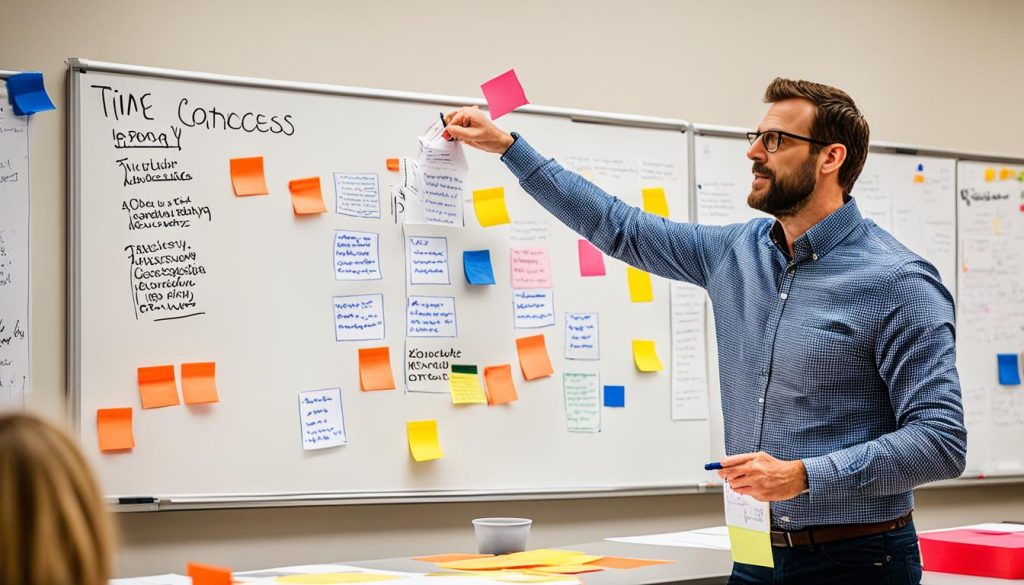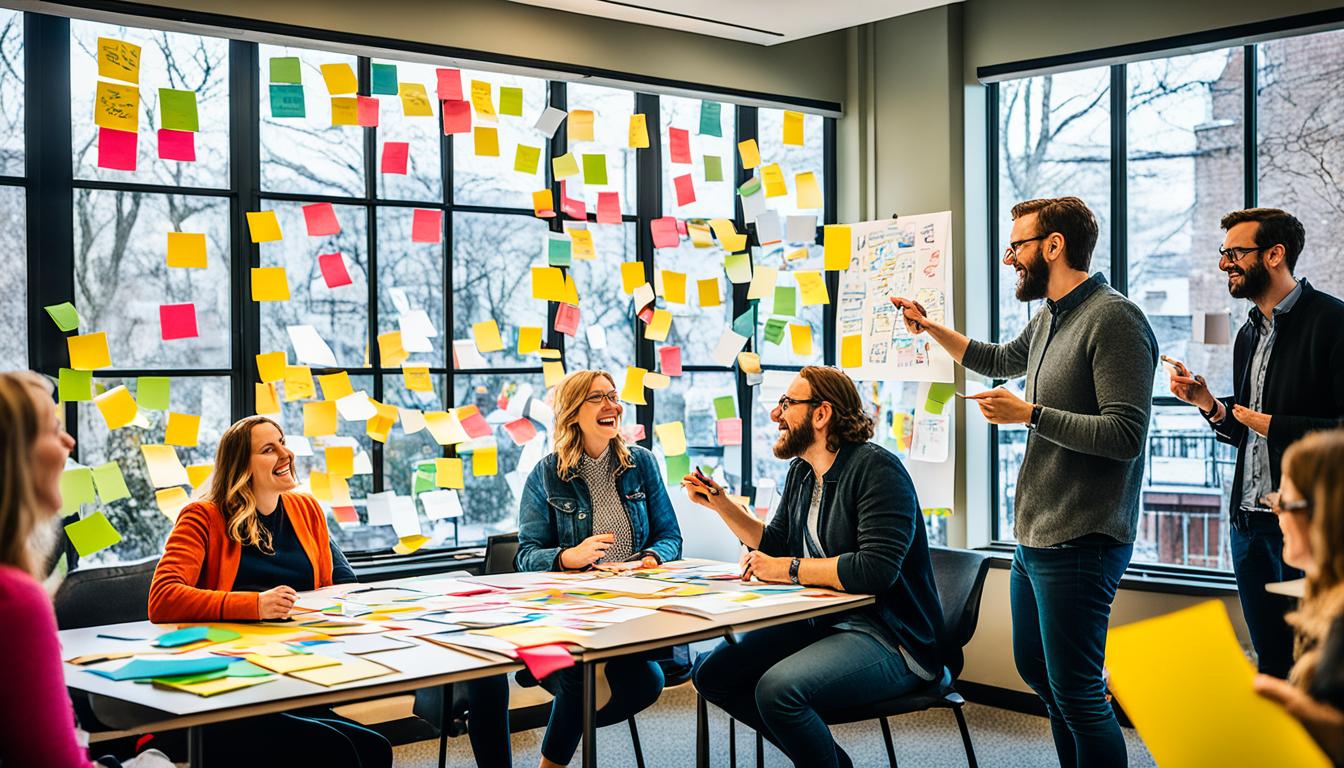Workshops are all about people: they involve people, are conducted by people, and aim to close the gaps in people’s communication. The more workshops we organize, the better we realize how similar they actually are, regardless of the methodology or tool used. This comprehensive checklist will help us prepare for any workshop and take care of all the tiny details – the enablers of the workshop’s success. Workshop planning is easier when we split it into a chain of logical steps, covering scoping, participants, format, agenda, and risk management.
Key Takeaways
- Workshops are centered around people and their communication needs.
- A comprehensive checklist can guide the organization of any successful workshop.
- Workshop planning involves logical steps, including scoping, participants, format, agenda, and risk management.
- Attention to detail is crucial for enabling the workshop’s success.
- Tailoring the workshop to the specific audience and goals is key to fostering creativity and innovation.
Defining the Workshop Purpose
Workshops help foster a research community that we care about. Beyond sharing ideas, workshops enable communities to identify the open questions worth solving and build a sense of what to work on next through group discussions like panels. Such “collaborative work” and collective brainstorming can assist a community in making progress towards organizing open questions into short-to-long term topics that are likely impactful and tractable given the field’s current state. As organizers, we can also influence the community’s attention towards underappreciated ideas and lesser-known researchers that we believe deserve more recognition, based on the workshop topic and keynote speakers we choose to invite.
Fostering a Research Community
Workshops are a great opportunity to help a community identify the open questions worth solving and build a sense of what to work on next. The group discussions, panels, and collaborative work during the workshop can assist the community in organizing open questions into short-to-long term topics that are likely impactful and tractable given the field’s current state.
Identifying Open Questions and Future Directions
Workshops provide a good networking opportunity for attendees. The venue allows people with similar interests to mingle, share ideas, and socialize. If the workshop is interdisciplinary, it can facilitate cross-pollination of ideas between fields, and if the workshop topic centers on an application, it can build bridges between academia and industry. As organizers, we’ll also get to meet speakers and authors on friendly terms, having just provided them an additional opportunity to showcase their work, and we’ll get to collaborate closely with organizers from different labs and companies.
Facilitating Networking and Cross-Pollination of Ideas
Selecting the Workshop Topic
When organizing a workshop, the first step is to choose a topic that aligns with your passions, the community’s needs, and the larger trends shaping the field. This often means identifying a novel subject that is not yet mainstream but holds immense potential to shape the future. Conversely, revisiting a topic explored in past workshops requires thoughtful consideration to keep the content fresh and distinct.
Choosing a Timely and Relevant Topic
To select a timely and relevant workshop topic, we must deeply understand the community we aim to serve. What pressing challenges are they grappling with? What innovative solutions or emerging technologies are capturing their attention? By tapping into these pressing concerns and burgeoning developments, we can position our workshop as a timely and valuable forum for nurturing creative talent, fostering innovation, and creativity development.
Determining the Appropriate Scope
The next step is to define the appropriate scope for the workshop topic. The right balance is crucial – a topic that is too broad may fail to rally participants around a specific purpose, while one that is too niche may struggle to attract a large enough audience for meaningful discussion. The sweet spot is to focus on a family of methods, such as offline reinforcement learning or invertible models, or a specific application domain, like computer vision for medicine or machine learning for climate. This approach allows us to unlock the potential of our participants and inspire ideas without sacrificing the depth and relevance of the workshop content.

Building the Organizing Team
You shouldn’t organize a creative workshop alone, as it’s too much work, and being a community event, it’s good to have multiple perspectives. Your first step is to recruit co-organizers. Choose your co-organizers carefully, from a range of institutions, subfields, and backgrounds. It works best when organizers have assigned roles, with each organizer taking ownership over some aspect of the workshop. Discuss and establish roles as soon as possible, ideally before you submit your proposal. Ensure each organizer understands and feels comfortable about their responsibilities.
Assigning Roles and Responsibilities
Assigning responsibilities to co-organizers helps track all the tasks so none are forgotten, in addition to sharing the workload. For example, one co-organizer could be responsible for managing the workshop’s email account and website, another for conducting outreach, another for maintaining contact with invited speakers, and another for recruiting a program committee and organizing reviewing.
Establishing a Lead Organizer
A critical role is the “lead organizer” to monitor everything at a high level. They can make executive decisions if needed and delegate incoming or scheduled tasks to ensure nothing falls through the cracks and everything happens on time. The lead organizer receives the most work and stress, being the one ultimately responsible for the workshop, so it’s important to select co-organizers who can be relied upon and will actively and enthusiastically help out.
Recruiting Co-Organizers with Diverse Backgrounds
Selecting co-organizers with diverse backgrounds, expertise, and perspectives can greatly enhance the creativity development and talent cultivation aspects of your workshop. By bringing together individuals with different strengths and experiences, you can unlock the potential of your organizing team and foster a culture of innovation that will be reflected in the workshop’s design and execution.
| Co-Organizer Role | Responsibilities |
|---|---|
| Website and Email Management | Maintain the workshop’s online presence, including the website and email account |
| Outreach and Promotion | Coordinate marketing efforts to attract participants and build awareness |
| Speaker Liaison | Manage communication and logistics with invited speakers and facilitators |
| Program Committee | Recruit and organize the review process for workshop submissions |
By assembling a diverse and dedicated organizing team, you can leverage the collective creative thinking techniques and artistic expression of your co-organizers to inspire ideas, foster innovation, and nurture creative talent throughout the workshop planning and execution process.
Scoping and Understanding the Problem
The better we understand the problem we are trying to solve with the workshop, the smoother the workshop will be. If we cannot clearly define the problem, the workshop will fall apart. It’s important to formulate the problem statement in a negative way (risk of…, lack of…, low…, prefixes ‘un’ and ‘in’) rather than as an attempt to push a preconceived solution.
Formulating the Problem Statement
Accurately defining the problem is the first step towards creating an effective workshop. We need to pinpoint the specific issues, challenges, or opportunities that the workshop aims to address. This requires a deep understanding of the target audience, their needs, and the broader context in which the problem exists.
Assessing the Suitability of a Workshop Format
Workshops are a powerful tool that can help tackle problems where conventional methods like presentations or discussions won’t suffice. Workshops are capable of aligning people, reaching agreements, engaging participants, and allowing them to have fun during the hard brainwork. However, if the goal is simply to share reliable and accurate information, a straightforward meeting may be more suitable than a workshop.
Gathering Available Information
A problem doesn’t exist in a vacuum, so it’s important to gather any information that is already available. We don’t want participants to waste time writing known information again from scratch or complaining that they didn’t know certain information was needed. Preparing some information in advance, such as partially pre-filling a workshop canvas, can help avoid these issues and ensure a more productive session.

Nurturing Creative Talent
Workshops are all about
nurturing creative talent
, and even the best technique won’t help you extract good ideas from the wrong people. Depending on the workshop subject, we’ll need to involve people with
suitable knowledge and skills
, such as technical (engineering, data science, quality assurance), user experience (design, research, content), and operations, marketing, finances, and so on. The
appropriate expertise
should be present in the workshop.
Identifying Relevant Expertise and Roles
When choosing the specific individuals to participate, we need to consider their
connection to the subject
, such as topic promoters, domain experts, and representatives from different local contexts. We also need to decide whether we need decision-makers, knowledge-keepers, or both, as their inclinations may differ.
Selecting Appropriate Participants
Not only do the participants matter, but also the way they interact with each other. We need to consider the
number of representatives
of each role or function, ensuring equal representation, and whether the team will collaborate all together or split into working groups. Efficient collaboration is possible in groups of 3-5 people, and larger teams may need to be split into smaller groups.
Fostering Inclusive and Productive Team Dynamics
By
fostering inclusive and productive team dynamics
, we can create an environment that
unlocks the potential
of our participants and
inspires their ideas
and
artistic expression
. This, in turn, will help us
cultivate creative talent
and
foster innovation
Determining the Workshop Format
One of the key decisions in organizing a creativity development workshop is whether to hold it online or offline. Each format has its own advantages and considerations, such as the ability to reach a wider talent cultivation audience online or the benefits of in-person artistic expression interaction offline. The organizers should carefully weigh the pros and cons of each approach based on the workshop’s goals and the target audience.
In addition to the online/offline decision, organizers must also determine the appropriate collaboration modes for the workshop. This could include individual work, small group discussions, larger group activities, and opportunities for open-ended imagination exercises brainstorming. The chosen collaboration modes should be tailored to the workshop’s objectives and the needs of the participants.
Choosing Between Online or Offline Delivery
When deciding between an online or offline format, organizers should consider factors such as the creative thinking techniques geographic distribution of the target audience, the need for hands-on activities, and the desired level of inspiring ideas interaction and engagement. Online workshops can reach a broader audience but may lack the interpersonal connections and spontaneity of in-person events. Offline workshops offer more nurturing creative talent immersive experiences but can be limited by venue constraints and travel requirements.
Deciding on Collaboration Modes
The choice of collaboration modes should be driven by the workshop’s fostering innovation objectives and the needs of the participants. Individual work can foster unlocking potential deeper exploration of ideas, while small group discussions can encourage talent cultivation cross-pollination and collective problem-solving. Larger group activities can promote artistic expression broader engagement and alignment, and open-ended brainstorming can stimulate creativity development innovative thinking.
Incorporating Interactive Elements
Regardless of the format, successful workshops incorporate imagination exercises interactive elements that engage the participants and foster active learning. This could include hands-on exercises, creative activities, live demonstrations, or creative thinking techniques interactive software tools. The goal is to keep the participants actively involved and enthusiastic throughout the workshop, inspiring ideas unlocking their creative potential and fostering personal growth.

Crafting the Workshop Agenda
When planning the workshop agenda, it’s important to start by defining the expected outputs and deliverables. This could include immediate artifacts like action plans, priority lists, or vision documents, as well as longer-term outcomes like improved team alignment, better understanding of the problem, or a plan for future collaboration. Visualizing the ideal result at the beginning will help guide the agenda development.
Defining Expected Outputs and Deliverables
The workshop agenda should incorporate a variety of engaging activities that keep the participants active and interested. This could include brainstorming sessions, group discussions, hands-on exercises, and creative problem-solving tasks. The goal is to strike a balance between information sharing and interactive collaboration.
Planning for Engaging Activities
In addition to planned activities, it’s crucial to allocate sufficient time for open-ended discussion and collaboration among the participants. This allows them to explore ideas in depth, uncover new connections, and develop a shared understanding of the workshop’s key themes and objectives.
Allocating Time for Discussion and Collaboration
By focusing on these key elements of the workshop agenda, organizers can create a transformative experience that nurtures creative talent, fosters innovation, and unlocks the potential of the participants through inspiring ideas, imagination exercises, and creative thinking techniques.

Managing Risks and Contingencies
No workshop is without its challenges, so it’s important for organizers to anticipate potential issues and develop mitigation strategies. This could include technical difficulties, logistical problems, participant engagement challenges, or unexpected schedule changes. By identifying these risks in advance, organizers can be better prepared to address them if they arise during the workshop.
Anticipating Potential Challenges
The organizing team should carefully consider the various obstacles that could arise during the workshop, such as technology malfunctions, venue-related complications, or difficulties keeping participants engaged and focused. Having a thorough understanding of these potential challenges will allow the team to proactively develop strategies to overcome them.
Developing Mitigation Strategies
Once the potential challenges have been identified, the organizing team should develop specific mitigation strategies to address them. This could include having a co-facilitator to assist with technical issues, building in flexibility in the agenda to adapt to changes, and establishing clear communication channels to address participant concerns. By having a plan in place, the team can quickly respond to any issues that arise during the workshop.
Ensuring Smooth Execution
Ultimately, the goal of the risk management process is to ensure the workshop is executed smoothly, with minimal disruptions or delays. By anticipating challenges and having a plan in place, organizers can focus on delivering a valuable and engaging experience for the participants. Through proactive planning and effective contingency measures, the workshop can navigate any unexpected obstacles and provide a seamless and transformative experience for all involved.
Fostering Innovation
One of the key objectives of organizing a creative workshop is to foster innovation and unlock the creative potential of the participants. This can be achieved through a variety of exercises and activities designed to inspire ideas and stimulate imagination. These may include brainstorming sessions, thought experiments, visual thinking techniques, and opportunities for artistic expression.
Inspiring Ideas and Imagination Exercises
By incorporating activities that encourage creativity development and unlocking potential, we can create an environment that inspires participants to explore new possibilities and push the boundaries of their thinking. Brainstorming sessions, where participants freely generate and build upon each other’s ideas, can unleash a surge of inspiring ideas. Thought experiments that challenge participants to imagine hypothetical scenarios can also stimulate imagination and uncover novel solutions.
Creative Thinking Techniques
In addition to idea generation, the workshop should also incorporate structured creative thinking techniques that help participants approach problems from new perspectives. This could include tools like lateral thinking, mind mapping, and design thinking methodologies. By exposing participants to these techniques, the workshop can help cultivate their creative problem-solving skills and unlock their talent cultivation.
Unlocking Potential through Artistic Expression
Allowing participants to engage in artistic expression, such as drawing, painting, or creative writing, can be a powerful way to unlock their creative potential. These activities encourage a different mode of thinking and can help participants access their inner creativity in ways that more analytical exercises may not. Incorporating artistic elements into the workshop can lead to unexpected insights and innovative solutions, ultimately fostering innovation and personal growth.
Conclusion
Organizing a successful creative workshop that nurtures creative talent, fosters innovation, and unlocks the full potential of your participants requires meticulous planning and attention to a wide range of factors. By following the comprehensive checklist outlined in this article, we have provided you with a roadmap to create an empowering and transformative experience.
At the heart of a truly impactful workshop lies the ability to inspire ideas, stimulate imagination, and provide the necessary tools and environment for creative thinking to thrive. Through carefully curated imagination exercises and the incorporation of creative thinking techniques, we can cultivate an atmosphere that unlocks the artistic expression and personal growth of each participant.
Remember, the success of your workshop hinges on your dedication to talent cultivation and your commitment to creativity development. By embracing this holistic approach, you will not only foster a culture of innovation but also create a lasting impact on the lives of those you serve. Dare to challenge the status quo, push the boundaries of what’s possible, and inspire the next generation of creative leaders.
FAQ
What is the purpose of organizing creative workshops?
How do you choose the right workshop topic?
How do you build an effective organizing team?
How do you ensure the workshop is tailored to the right participants?
What are the key considerations when choosing the workshop format?
How do you craft an engaging workshop agenda?
How do you manage risks and contingencies for the workshop?
How can you foster innovation and unlock creative potential during the workshop?
Source Links
- https://www.smashingmagazine.com/2023/03/organizing-design-workshops-checklist/
- https://medium.com/design-bridges/workshop-checklist-a4895fe7add0
- https://rowanmcallister.github.io/post/workshops/
